Leadership Module: University 4R's Reflection on Group Work
VerifiedAdded on 2022/10/11
|6
|1771
|34
Homework Assignment
AI Summary
This assignment presents a student's 4R's reflection on a group work experience, focusing on reporting, relating, reasoning, and reconstructing. The student analyzes the group's approach to a task involving developing a governance structure and capability map for Blue Parcel, a company seeking to develop a new logistics model. The reflection discusses the roles of individual, small group, and large group contributions, emphasizing the importance of teamwork, communication, and shared responsibility. The student highlights the benefits of group work, such as efficiency, skill development, and team cohesion, while also acknowledging the need for effective leadership and a cohesive team structure. The reflection references several academic sources to support the student's observations on group dynamics, leadership, and the impact of teamwork on learning and professional development. The student concludes by emphasizing the value of teamwork in enhancing learning capabilities and building essential skills for future professional roles.
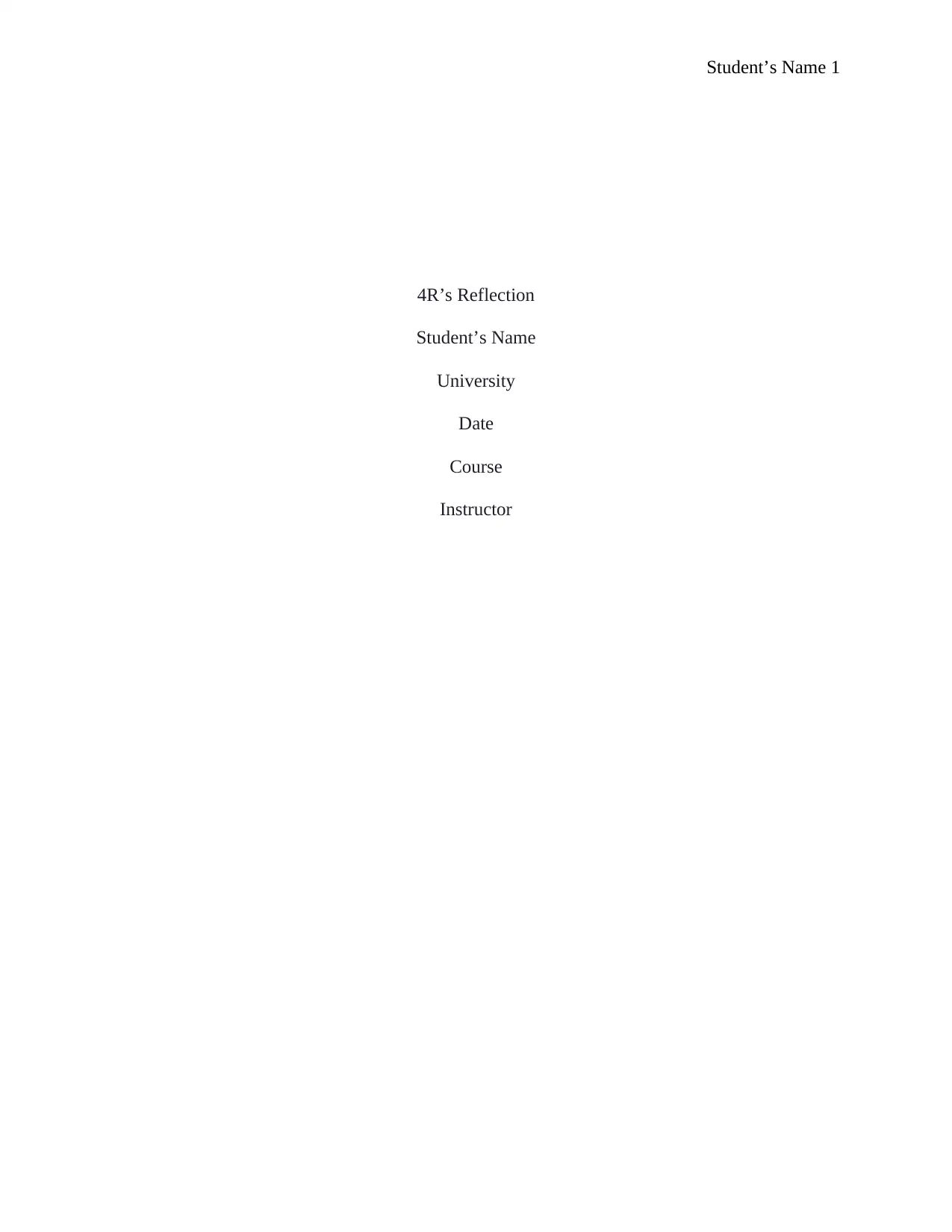
Student’s Name 1
4R’s Reflection
Student’s Name
University
Date
Course
Instructor
4R’s Reflection
Student’s Name
University
Date
Course
Instructor
Paraphrase This Document
Need a fresh take? Get an instant paraphrase of this document with our AI Paraphraser
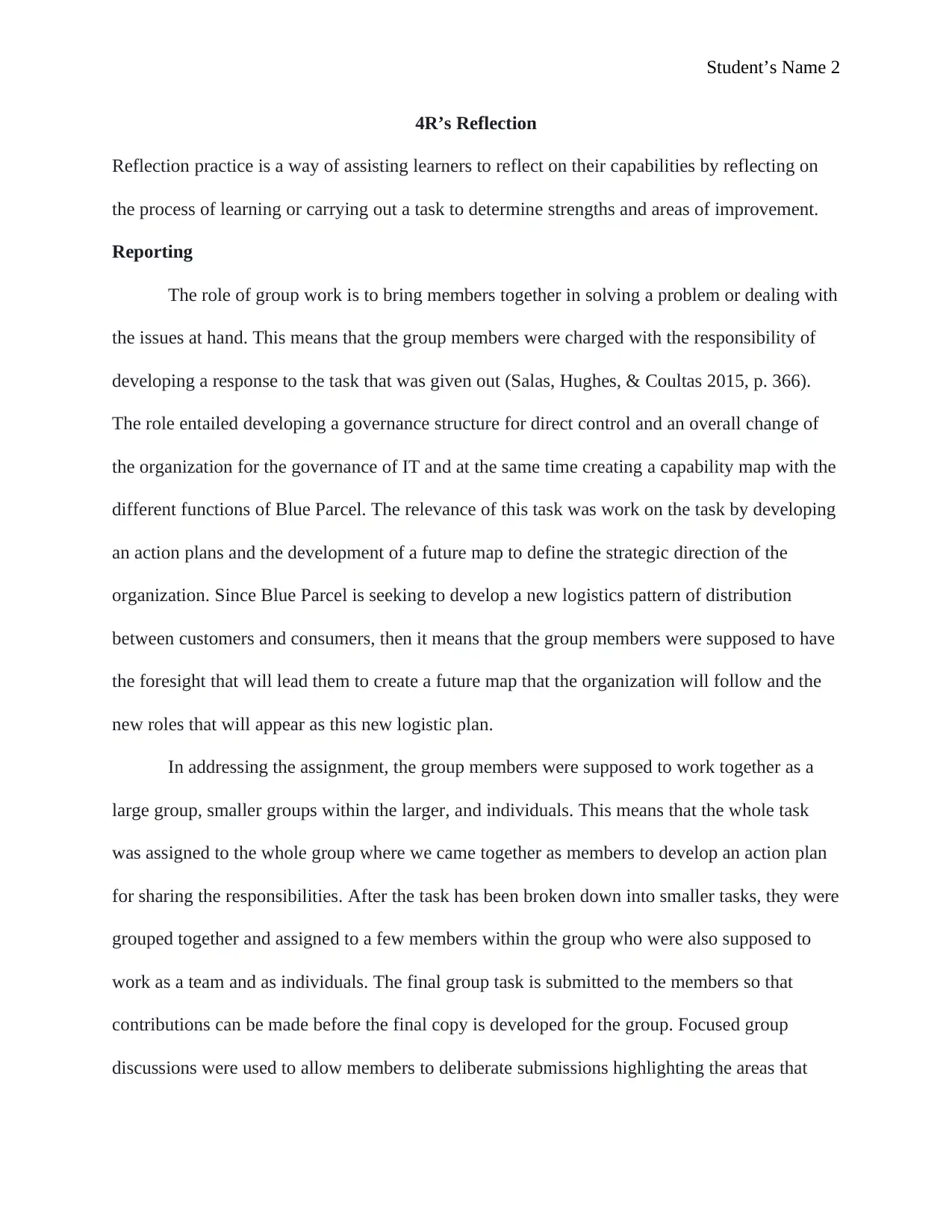
Student’s Name 2
4R’s Reflection
Reflection practice is a way of assisting learners to reflect on their capabilities by reflecting on
the process of learning or carrying out a task to determine strengths and areas of improvement.
Reporting
The role of group work is to bring members together in solving a problem or dealing with
the issues at hand. This means that the group members were charged with the responsibility of
developing a response to the task that was given out (Salas, Hughes, & Coultas 2015, p. 366).
The role entailed developing a governance structure for direct control and an overall change of
the organization for the governance of IT and at the same time creating a capability map with the
different functions of Blue Parcel. The relevance of this task was work on the task by developing
an action plans and the development of a future map to define the strategic direction of the
organization. Since Blue Parcel is seeking to develop a new logistics pattern of distribution
between customers and consumers, then it means that the group members were supposed to have
the foresight that will lead them to create a future map that the organization will follow and the
new roles that will appear as this new logistic plan.
In addressing the assignment, the group members were supposed to work together as a
large group, smaller groups within the larger, and individuals. This means that the whole task
was assigned to the whole group where we came together as members to develop an action plan
for sharing the responsibilities. After the task has been broken down into smaller tasks, they were
grouped together and assigned to a few members within the group who were also supposed to
work as a team and as individuals. The final group task is submitted to the members so that
contributions can be made before the final copy is developed for the group. Focused group
discussions were used to allow members to deliberate submissions highlighting the areas that
4R’s Reflection
Reflection practice is a way of assisting learners to reflect on their capabilities by reflecting on
the process of learning or carrying out a task to determine strengths and areas of improvement.
Reporting
The role of group work is to bring members together in solving a problem or dealing with
the issues at hand. This means that the group members were charged with the responsibility of
developing a response to the task that was given out (Salas, Hughes, & Coultas 2015, p. 366).
The role entailed developing a governance structure for direct control and an overall change of
the organization for the governance of IT and at the same time creating a capability map with the
different functions of Blue Parcel. The relevance of this task was work on the task by developing
an action plans and the development of a future map to define the strategic direction of the
organization. Since Blue Parcel is seeking to develop a new logistics pattern of distribution
between customers and consumers, then it means that the group members were supposed to have
the foresight that will lead them to create a future map that the organization will follow and the
new roles that will appear as this new logistic plan.
In addressing the assignment, the group members were supposed to work together as a
large group, smaller groups within the larger, and individuals. This means that the whole task
was assigned to the whole group where we came together as members to develop an action plan
for sharing the responsibilities. After the task has been broken down into smaller tasks, they were
grouped together and assigned to a few members within the group who were also supposed to
work as a team and as individuals. The final group task is submitted to the members so that
contributions can be made before the final copy is developed for the group. Focused group
discussions were used to allow members to deliberate submissions highlighting the areas that
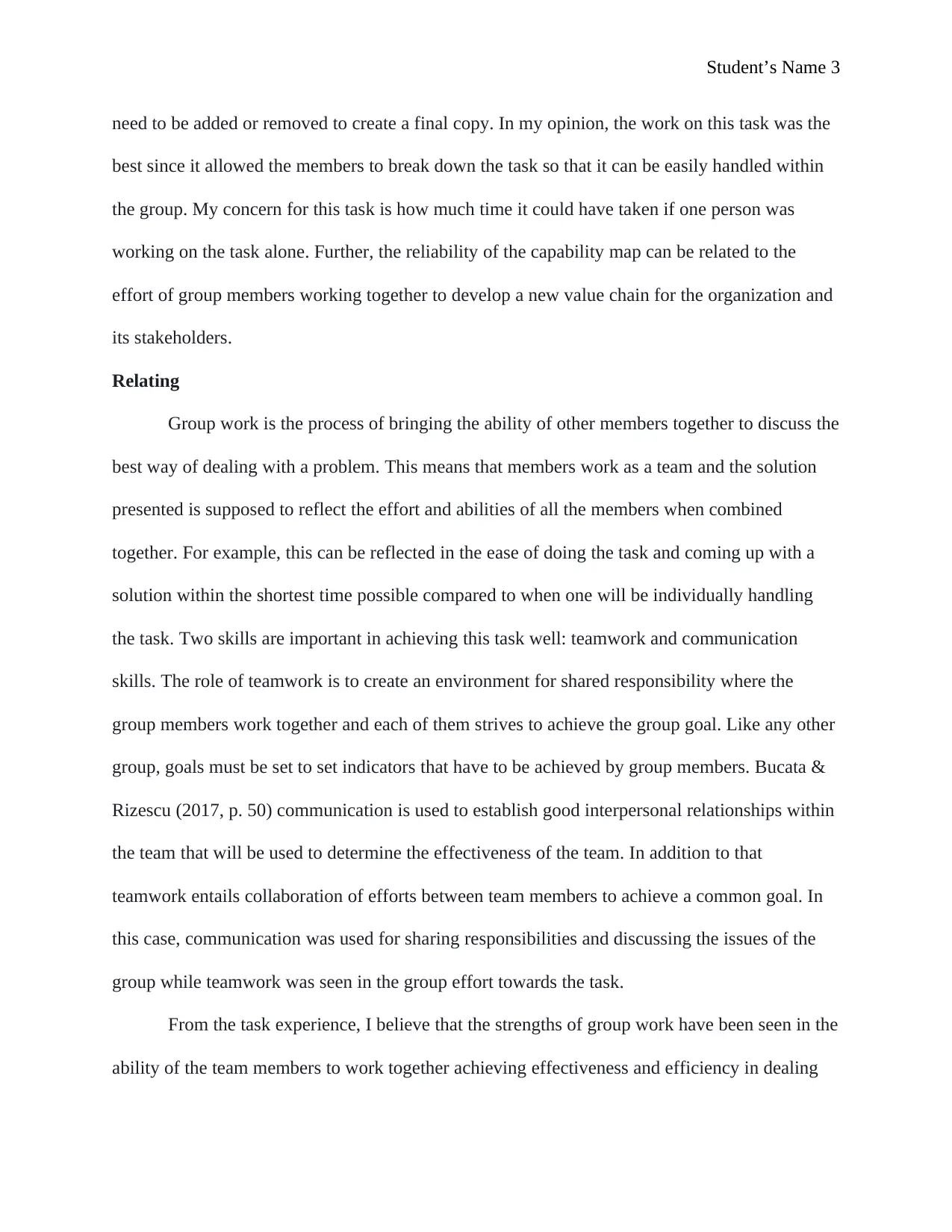
Student’s Name 3
need to be added or removed to create a final copy. In my opinion, the work on this task was the
best since it allowed the members to break down the task so that it can be easily handled within
the group. My concern for this task is how much time it could have taken if one person was
working on the task alone. Further, the reliability of the capability map can be related to the
effort of group members working together to develop a new value chain for the organization and
its stakeholders.
Relating
Group work is the process of bringing the ability of other members together to discuss the
best way of dealing with a problem. This means that members work as a team and the solution
presented is supposed to reflect the effort and abilities of all the members when combined
together. For example, this can be reflected in the ease of doing the task and coming up with a
solution within the shortest time possible compared to when one will be individually handling
the task. Two skills are important in achieving this task well: teamwork and communication
skills. The role of teamwork is to create an environment for shared responsibility where the
group members work together and each of them strives to achieve the group goal. Like any other
group, goals must be set to set indicators that have to be achieved by group members. Bucata &
Rizescu (2017, p. 50) communication is used to establish good interpersonal relationships within
the team that will be used to determine the effectiveness of the team. In addition to that
teamwork entails collaboration of efforts between team members to achieve a common goal. In
this case, communication was used for sharing responsibilities and discussing the issues of the
group while teamwork was seen in the group effort towards the task.
From the task experience, I believe that the strengths of group work have been seen in the
ability of the team members to work together achieving effectiveness and efficiency in dealing
need to be added or removed to create a final copy. In my opinion, the work on this task was the
best since it allowed the members to break down the task so that it can be easily handled within
the group. My concern for this task is how much time it could have taken if one person was
working on the task alone. Further, the reliability of the capability map can be related to the
effort of group members working together to develop a new value chain for the organization and
its stakeholders.
Relating
Group work is the process of bringing the ability of other members together to discuss the
best way of dealing with a problem. This means that members work as a team and the solution
presented is supposed to reflect the effort and abilities of all the members when combined
together. For example, this can be reflected in the ease of doing the task and coming up with a
solution within the shortest time possible compared to when one will be individually handling
the task. Two skills are important in achieving this task well: teamwork and communication
skills. The role of teamwork is to create an environment for shared responsibility where the
group members work together and each of them strives to achieve the group goal. Like any other
group, goals must be set to set indicators that have to be achieved by group members. Bucata &
Rizescu (2017, p. 50) communication is used to establish good interpersonal relationships within
the team that will be used to determine the effectiveness of the team. In addition to that
teamwork entails collaboration of efforts between team members to achieve a common goal. In
this case, communication was used for sharing responsibilities and discussing the issues of the
group while teamwork was seen in the group effort towards the task.
From the task experience, I believe that the strengths of group work have been seen in the
ability of the team members to work together achieving effectiveness and efficiency in dealing
⊘ This is a preview!⊘
Do you want full access?
Subscribe today to unlock all pages.

Trusted by 1+ million students worldwide
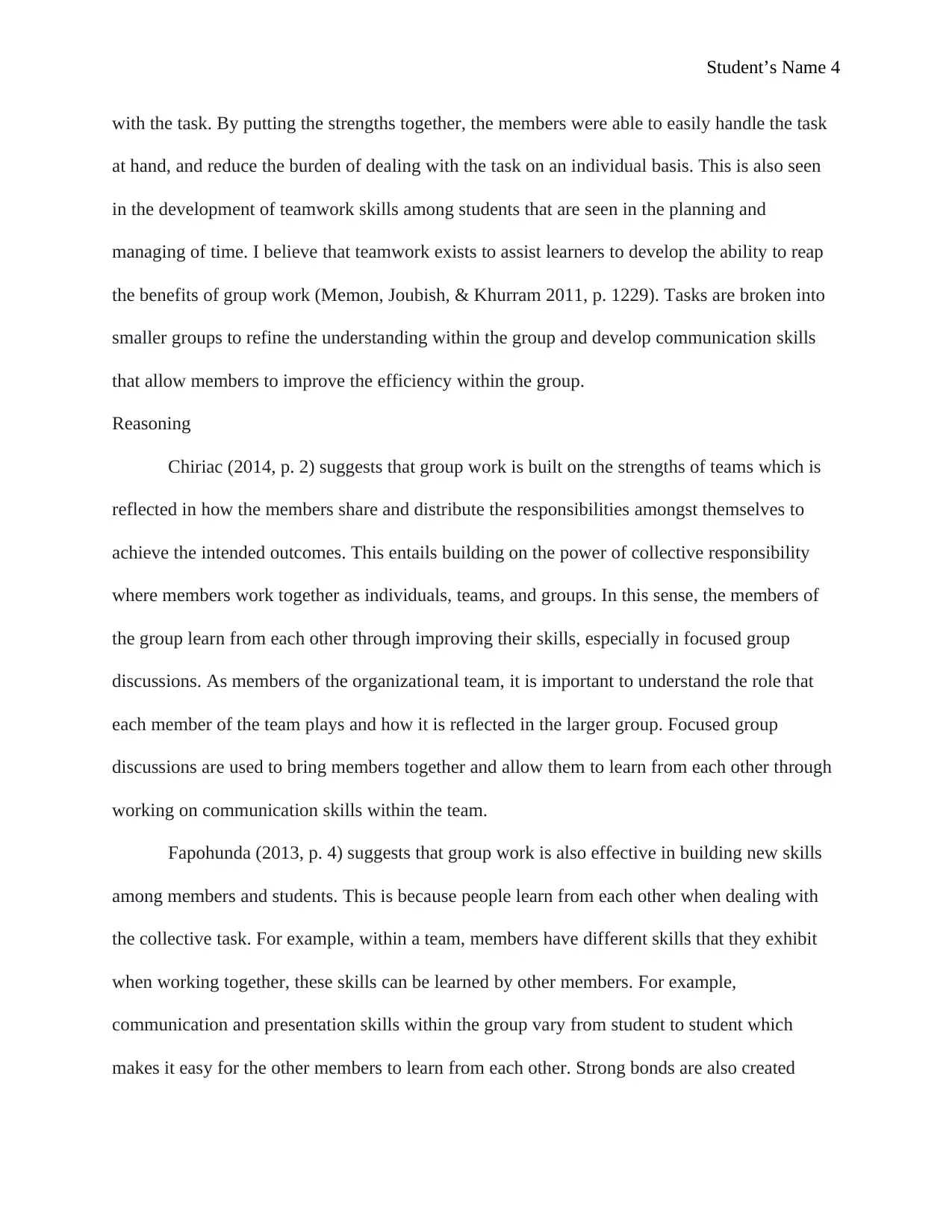
Student’s Name 4
with the task. By putting the strengths together, the members were able to easily handle the task
at hand, and reduce the burden of dealing with the task on an individual basis. This is also seen
in the development of teamwork skills among students that are seen in the planning and
managing of time. I believe that teamwork exists to assist learners to develop the ability to reap
the benefits of group work (Memon, Joubish, & Khurram 2011, p. 1229). Tasks are broken into
smaller groups to refine the understanding within the group and develop communication skills
that allow members to improve the efficiency within the group.
Reasoning
Chiriac (2014, p. 2) suggests that group work is built on the strengths of teams which is
reflected in how the members share and distribute the responsibilities amongst themselves to
achieve the intended outcomes. This entails building on the power of collective responsibility
where members work together as individuals, teams, and groups. In this sense, the members of
the group learn from each other through improving their skills, especially in focused group
discussions. As members of the organizational team, it is important to understand the role that
each member of the team plays and how it is reflected in the larger group. Focused group
discussions are used to bring members together and allow them to learn from each other through
working on communication skills within the team.
Fapohunda (2013, p. 4) suggests that group work is also effective in building new skills
among members and students. This is because people learn from each other when dealing with
the collective task. For example, within a team, members have different skills that they exhibit
when working together, these skills can be learned by other members. For example,
communication and presentation skills within the group vary from student to student which
makes it easy for the other members to learn from each other. Strong bonds are also created
with the task. By putting the strengths together, the members were able to easily handle the task
at hand, and reduce the burden of dealing with the task on an individual basis. This is also seen
in the development of teamwork skills among students that are seen in the planning and
managing of time. I believe that teamwork exists to assist learners to develop the ability to reap
the benefits of group work (Memon, Joubish, & Khurram 2011, p. 1229). Tasks are broken into
smaller groups to refine the understanding within the group and develop communication skills
that allow members to improve the efficiency within the group.
Reasoning
Chiriac (2014, p. 2) suggests that group work is built on the strengths of teams which is
reflected in how the members share and distribute the responsibilities amongst themselves to
achieve the intended outcomes. This entails building on the power of collective responsibility
where members work together as individuals, teams, and groups. In this sense, the members of
the group learn from each other through improving their skills, especially in focused group
discussions. As members of the organizational team, it is important to understand the role that
each member of the team plays and how it is reflected in the larger group. Focused group
discussions are used to bring members together and allow them to learn from each other through
working on communication skills within the team.
Fapohunda (2013, p. 4) suggests that group work is also effective in building new skills
among members and students. This is because people learn from each other when dealing with
the collective task. For example, within a team, members have different skills that they exhibit
when working together, these skills can be learned by other members. For example,
communication and presentation skills within the group vary from student to student which
makes it easy for the other members to learn from each other. Strong bonds are also created
Paraphrase This Document
Need a fresh take? Get an instant paraphrase of this document with our AI Paraphraser
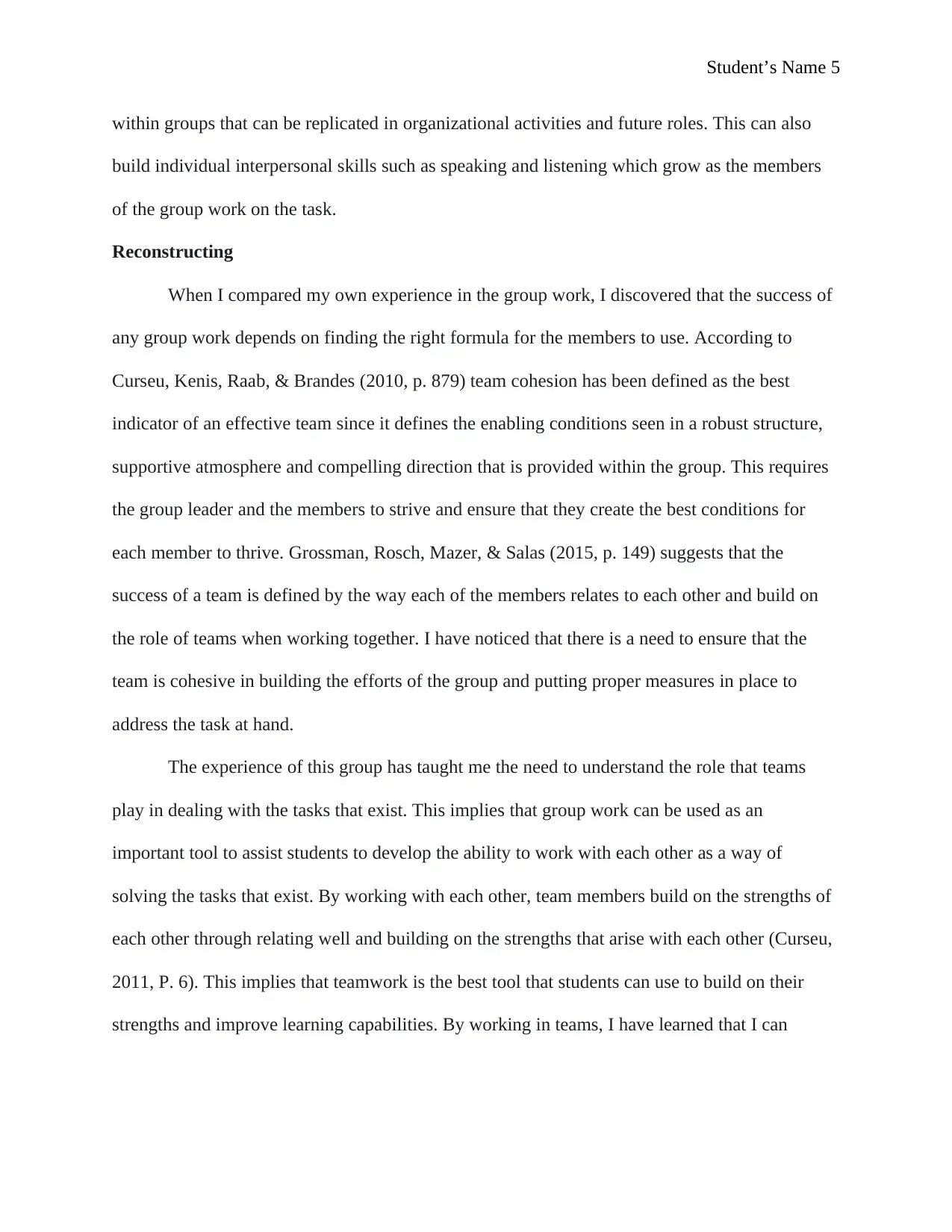
Student’s Name 5
within groups that can be replicated in organizational activities and future roles. This can also
build individual interpersonal skills such as speaking and listening which grow as the members
of the group work on the task.
Reconstructing
When I compared my own experience in the group work, I discovered that the success of
any group work depends on finding the right formula for the members to use. According to
Curseu, Kenis, Raab, & Brandes (2010, p. 879) team cohesion has been defined as the best
indicator of an effective team since it defines the enabling conditions seen in a robust structure,
supportive atmosphere and compelling direction that is provided within the group. This requires
the group leader and the members to strive and ensure that they create the best conditions for
each member to thrive. Grossman, Rosch, Mazer, & Salas (2015, p. 149) suggests that the
success of a team is defined by the way each of the members relates to each other and build on
the role of teams when working together. I have noticed that there is a need to ensure that the
team is cohesive in building the efforts of the group and putting proper measures in place to
address the task at hand.
The experience of this group has taught me the need to understand the role that teams
play in dealing with the tasks that exist. This implies that group work can be used as an
important tool to assist students to develop the ability to work with each other as a way of
solving the tasks that exist. By working with each other, team members build on the strengths of
each other through relating well and building on the strengths that arise with each other (Curseu,
2011, P. 6). This implies that teamwork is the best tool that students can use to build on their
strengths and improve learning capabilities. By working in teams, I have learned that I can
within groups that can be replicated in organizational activities and future roles. This can also
build individual interpersonal skills such as speaking and listening which grow as the members
of the group work on the task.
Reconstructing
When I compared my own experience in the group work, I discovered that the success of
any group work depends on finding the right formula for the members to use. According to
Curseu, Kenis, Raab, & Brandes (2010, p. 879) team cohesion has been defined as the best
indicator of an effective team since it defines the enabling conditions seen in a robust structure,
supportive atmosphere and compelling direction that is provided within the group. This requires
the group leader and the members to strive and ensure that they create the best conditions for
each member to thrive. Grossman, Rosch, Mazer, & Salas (2015, p. 149) suggests that the
success of a team is defined by the way each of the members relates to each other and build on
the role of teams when working together. I have noticed that there is a need to ensure that the
team is cohesive in building the efforts of the group and putting proper measures in place to
address the task at hand.
The experience of this group has taught me the need to understand the role that teams
play in dealing with the tasks that exist. This implies that group work can be used as an
important tool to assist students to develop the ability to work with each other as a way of
solving the tasks that exist. By working with each other, team members build on the strengths of
each other through relating well and building on the strengths that arise with each other (Curseu,
2011, P. 6). This implies that teamwork is the best tool that students can use to build on their
strengths and improve learning capabilities. By working in teams, I have learned that I can
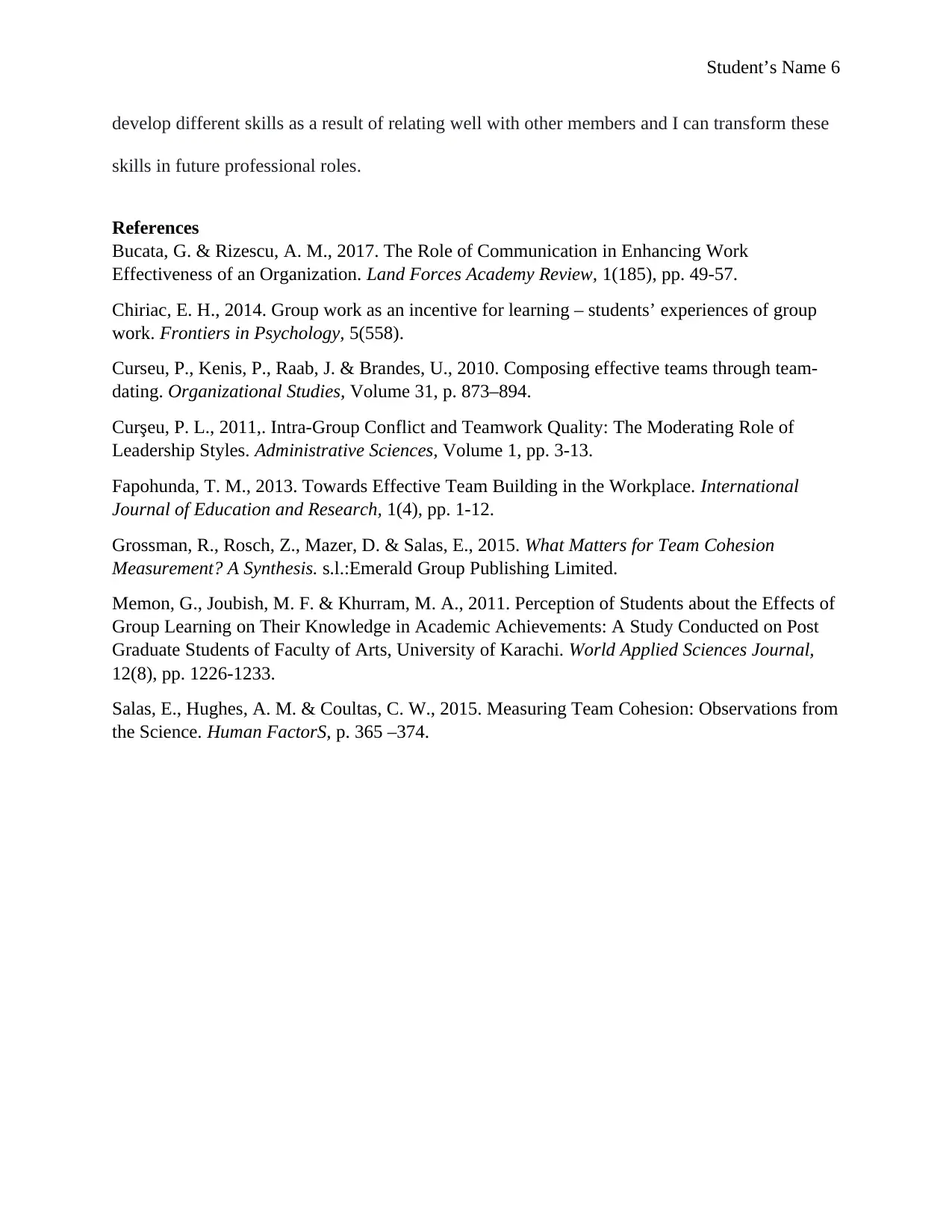
Student’s Name 6
develop different skills as a result of relating well with other members and I can transform these
skills in future professional roles.
References
Bucata, G. & Rizescu, A. M., 2017. The Role of Communication in Enhancing Work
Effectiveness of an Organization. Land Forces Academy Review, 1(185), pp. 49-57.
Chiriac, E. H., 2014. Group work as an incentive for learning – students’ experiences of group
work. Frontiers in Psychology, 5(558).
Curseu, P., Kenis, P., Raab, J. & Brandes, U., 2010. Composing effective teams through team-
dating. Organizational Studies, Volume 31, p. 873–894.
Curşeu, P. L., 2011,. Intra-Group Conflict and Teamwork Quality: The Moderating Role of
Leadership Styles. Administrative Sciences, Volume 1, pp. 3-13.
Fapohunda, T. M., 2013. Towards Effective Team Building in the Workplace. International
Journal of Education and Research, 1(4), pp. 1-12.
Grossman, R., Rosch, Z., Mazer, D. & Salas, E., 2015. What Matters for Team Cohesion
Measurement? A Synthesis. s.l.:Emerald Group Publishing Limited.
Memon, G., Joubish, M. F. & Khurram, M. A., 2011. Perception of Students about the Effects of
Group Learning on Their Knowledge in Academic Achievements: A Study Conducted on Post
Graduate Students of Faculty of Arts, University of Karachi. World Applied Sciences Journal,
12(8), pp. 1226-1233.
Salas, E., Hughes, A. M. & Coultas, C. W., 2015. Measuring Team Cohesion: Observations from
the Science. Human FactorS, p. 365 –374.
develop different skills as a result of relating well with other members and I can transform these
skills in future professional roles.
References
Bucata, G. & Rizescu, A. M., 2017. The Role of Communication in Enhancing Work
Effectiveness of an Organization. Land Forces Academy Review, 1(185), pp. 49-57.
Chiriac, E. H., 2014. Group work as an incentive for learning – students’ experiences of group
work. Frontiers in Psychology, 5(558).
Curseu, P., Kenis, P., Raab, J. & Brandes, U., 2010. Composing effective teams through team-
dating. Organizational Studies, Volume 31, p. 873–894.
Curşeu, P. L., 2011,. Intra-Group Conflict and Teamwork Quality: The Moderating Role of
Leadership Styles. Administrative Sciences, Volume 1, pp. 3-13.
Fapohunda, T. M., 2013. Towards Effective Team Building in the Workplace. International
Journal of Education and Research, 1(4), pp. 1-12.
Grossman, R., Rosch, Z., Mazer, D. & Salas, E., 2015. What Matters for Team Cohesion
Measurement? A Synthesis. s.l.:Emerald Group Publishing Limited.
Memon, G., Joubish, M. F. & Khurram, M. A., 2011. Perception of Students about the Effects of
Group Learning on Their Knowledge in Academic Achievements: A Study Conducted on Post
Graduate Students of Faculty of Arts, University of Karachi. World Applied Sciences Journal,
12(8), pp. 1226-1233.
Salas, E., Hughes, A. M. & Coultas, C. W., 2015. Measuring Team Cohesion: Observations from
the Science. Human FactorS, p. 365 –374.
⊘ This is a preview!⊘
Do you want full access?
Subscribe today to unlock all pages.

Trusted by 1+ million students worldwide
1 out of 6
Related Documents
Your All-in-One AI-Powered Toolkit for Academic Success.
+13062052269
info@desklib.com
Available 24*7 on WhatsApp / Email
![[object Object]](/_next/static/media/star-bottom.7253800d.svg)
Unlock your academic potential
Copyright © 2020–2025 A2Z Services. All Rights Reserved. Developed and managed by ZUCOL.





